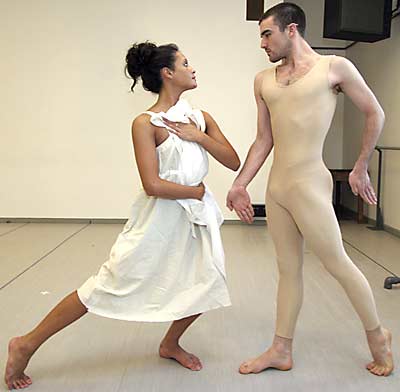
Page One
• Ashenfelter devises inventive real-world tests to illuminate labor economics
• Dance festival to feature legendary French ballet
Inside
• Hau unlocks secrets of tropical birds through field study on the Galápagos
• University offers new backup care program — for children through elderly
• Group continues efforts to improve child care
• Seldom seen art of Russia exhibited at art museum
• 1,200 expected to attend Alumni Day
People
• Early career scientists earn awards from NSF for their research projects
• People, spotlight
Almanac
• Nassau notes
• Calendar of events
• By the numbers

Dance festival to feature legendary French ballet
Princeton NJ — A legendary French ballet by Vaslav Nijinsky — the choreography of which was lost for decades — will be performed by Princeton students Friday through Sunday, Feb. 24-26, at the Berlind Theatre.

Senior Silas Riener (right), playing the faun in Vaslav Nijinsky’s legendary French ballet “L’Après-midi d’un Faune,” pursues the lead nymph, played by junior Natasha Kalimada, in the Princeton production, opening Feb. 24 at the Berlind Theatre. (photo by John Jameson)
“L’Après-midi d’un Faune” or “The Afternoon of a Faun,” which was first performed in Paris in 1912, is one of only four ballets created by Nijinsky, a Russian choreographer who heralded a new era in dance. The piece, with a score by Claude Debussy, is regarded as a groundbreaking choreography that broke from the traditions of classical ballet with its sensuality and fresh dance vocabulary. The story begins with a faun watching seven nymphs preparing for a bath. All the nymphs run off except for one, with whom the faun has a romantic encounter.
The piece was performed for several years in numerous cities, but after the tour ended the choreography was lost to time. Nijinsky created his own system of dance notation, in which he attempted to describe the exact movements — down to the thumb position and head angles — of all the dancers, but no one knew how to read it, so the piece lay un-danced in the British Library for 40 years. Several ballet companies performed memory-based versions reconstructed by former dancers who recalled basic ideas but lacked the specific choreography.
In 1984, dance notation scholars Ann Hutchinson Guest and Claudia Jeschke discovered scores of several common exercises for ballet technique that Nijinsky had notated. Since the exercises survived intact, these scores served as a Rosetta stone for decoding Nijinsky’s “Faune.” Their translation reveals a more logical development of the story line, a greater subtlety of movement and a more musical style of performance than memory-based restagings.
The first American production of the restored version of the piece was performed at the Juilliard School in 1989 with Rebecca Lazier, acting head of Princeton’s Program in Theater and Dance, in the role of the lead nymph. Nijinsky’s ballet is part of the annual Princeton Spring Dance Festival, directed by Lazier and Meghan Durham, lecturer in the Council of the Humanities and theater and dance.
The Princeton performance is an opportunity for eight students to dance one of the formative ballet pieces of the 20th century as well as to work with several outside collaborators. Tina Curran, the director of the Language for Dance Centre in London, has been at Princeton since September to set the ballet. Guest and Jeschke arrived on campus in January to coach the dancers in the nuance of style the piece requires. The piece will have a backdrop and costumes based on those in the original production, designed by Léon Bakst. The project is supported by the Program in Theater and Dance, the David A. Gardner ’69 Magic Project and the University Art Museum.
“L’Après-midi d’un Faune” is being performed in conjunction with an exhibition at the art museum opening Feb. 25 called “Mir Iskusstva: Russia’s Age of Elegance,” which will feature works of art from turn-of-the-century Russia that have seldom been seen because they were suppressed by the Soviets (see story on page 4).
The annual Princeton Spring Dance Festival features student performers in pieces composed by faculty, guest choreographers and students. Also on the program is a piece called “The Memory of Water,” choreographed by Lazier with music by Paul Lansky, the William Conant Professor of Music. Durham has collaborated with composer Michael Wall to create “I Am My Only Risk,” a piece inspired by desert landscapes. Guest choreographer Gabri Christa will use projections by Accra Shepp, lecturer in the Council of the Humanities and visual arts, for her work, “Invisible Friend.” In addition, the program will feature selected student work from fall semester classes.
Performances are set for: 8 p.m. Friday, Feb. 24; 3:30 and 8 p.m. Saturday, Feb. 25; and 2 p.m. Sunday, Feb. 26. For tickets, call the McCarter Theatre Center box office at 258-2787.